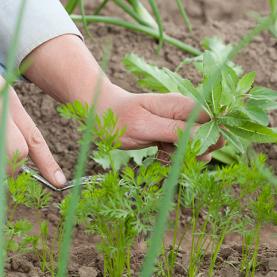The history of market gardening
Throughout history, market gardening has been in constant development. The ancient ornamental garden evolved into the medieval vegetable plot established in the former marsh areas of Paris during the Enlightenment. In the 19th century, scientific innovations improved techniques and tools which paved the way for intensive cultivation. A desire to return to extensive organic cultivation emerged towards the end of the 20th century.
From the vegetable plot to the market garden
The domestication of edible plants and the first cultivation techniques appeared in prehistory and developed near the first dwellings occupied by settling populations.
From Antiquity, horticulture practised in cities made way for the ornamental garden which played on the aesthetic arrangement of plants and the stimulation of sight and smell. It gradually developed into a new food concept: the vegetable plot.
In the Middle Ages, peasant farmers’ vegetable plots were planted with vegetables which could be stored, such as cabbages, peas and beans. These vegetables were used to feed the farm’s inhabitants but were also produced for sale on the market. Monasteries too had their vegetable gardens which fed the ecclesiastical community but also contained herbs and medicinal plants. Vegetable plots had to expand in order to feed growing urban populations and thus became established beyond town walls from the 13th century.
The vegetable garden continued to evolve throughout the modern era. From the 16th century, thanks to sea voyages and the discovery of new continents, new edible plants arrived in Europe. These plants, including potatoes, sweetcorn and tomatoes, radically changed eating habits. In the 17th century, intensive vegetable cultivation emerged in the Netherlands and increased productivity on intensively worked land meant that the cultivable areas around towns were able to supply growing populations with fruit and vegetables. In 18th century France, vegetable gardens became established in the former marsh areas of Paris.
The industrial revolution of the 19th century marked a turning point for market gardening. Mechanisation extended to both agricultural tools and growing techniques. In chemistry, the discovery of the importance of phosphorous and nitrogen for the growth of plants led to the production of artificial fertilisers and thus improved intensive farming. Likewise, preserving techniques progressed. The invention of the steam engine, followed by that of the combustion engine lead to the development of transport networks which ‘reduced’ the distance between urban and agricultural areas. Crops moved away from the towns and into rural areas with more suitable growing conditions. Private allotment gardens developed within towns and provided fresh fruit and vegetables for subsistence purposes. Maintained collectively, these gardens were the precursors to today’s community allotments.
In the 20th century, production intensified along with the constantly growing population. Industrial machines replaced many manual operations. Agricultural machines became multipurpose, meeting the requirements of the different stages of cultivation, although manual work remained essential for certain operations, such as the harvesting of some delicate produce. Trade between continents and evolving dietary habits have influenced market gardening practices. One of the consequences of this has been the increase in extensive organic cultivation, using the natural resources of cultivated areas, and the reintroduction of forgotten varieties of vegetables.
ELGER, Roger, 2015. Les nouveaux potagers, sur bottes de paille, sur buttes, sous couvert végétal permanent, sur lasagnes, en carrés, sous abri, en bacs. Paris : Éditions Rustica. ISBN 9782815306096
MAPPA, Dominique, 2010. Les productions légumières : cahiers d’activité. Dijon : Educagri Éditions. ISBN 9782844447937
MAZOYER, Marcel et ROUDART, Laurence, 2002. Histoire des agricultures du monde : du néolithique à la crise économique. Paris : Éditions du Seuil. ISBN 9782020530613.
PITRAT, Michel et FOURY, Claude, 2015. Histoire de légumes : des origines à l’orée du XXe siècle. Paris : Éditions Quae. ISBN 9782759223558.
QUELLIER, Florent, 2012. Histoire du jardin potager. Paris : Armand Colin. ISBN 9782200271770
VERCELLONI, Matteo, 2009. L’invention du jardin occidental. Rodez : Éditions du Rouergue. ISBN 9782812600470




